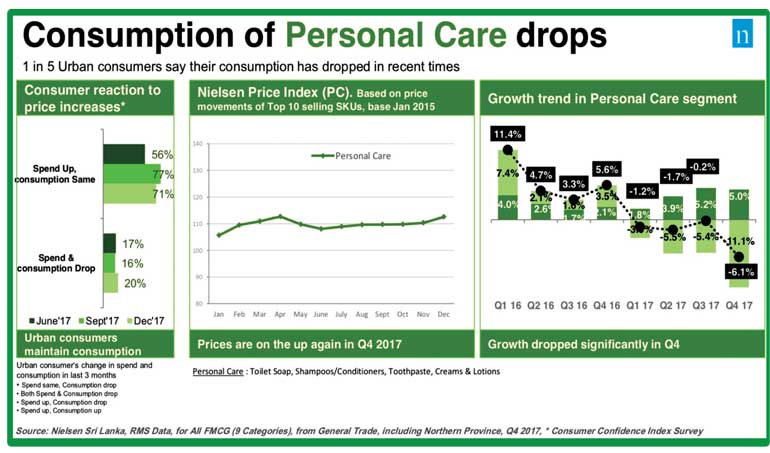Wednesday Apr 16, 2025
Wednesday Apr 16, 2025
Tuesday, 27 March 2018 00:00 - - {{hitsCtrl.values.hits}}
The other day I received a call from Germany from the Sri Lankan Tourism team attending the premier tourism exhibition ITB. The objective of the call was whether I could support the task of implementing the ‘destination marketing campaign’ for Sri Lanka Tourism.
I obliged to the Minister, even though this initiative was off the ground with the top seven global advertising agencies way back in 2015, but alas, the board was dissolved. As we reach the end of quarter 1-2018, the country is yet grappling to launch this key initiative that will clearly change the perceptions of Sri Lanka.
Cracks appeared in 2015
In my view, the 2015 episode of the ‘destination marketing campaign’ was the first time Sri Lanka saw the cracks appearing of the current Government. Thereafter Sri Lanka saw the resignation of the Minister of Defence followed by the bond scam that shook the country. This led to the resignation of the Central Bank Governor followed by that of the Minister of Finance which sure tarnished the Yahapalanaya ethos.
The Local Government election that was held on 10 February saw the feedback from Sri Lanka. Only 29% of the people voted for the Government which was drastic change to the initial mandate given on 8 January 2015. A sad situation for the country.
Brand value crashes 
If we take a neutral perspective and examine the data from an organisation like Brand Finance, which computes the country brand values across the globe, the results validate the above analysis.
Even after a brutal Eelam 4 war and war crimes allegations post 2009, the brand value grew by 20-35% until 2015. Thereafter the growth stunted to just single digit and we have ended last year at $ 78 billion at a mere 4% growth as against the year before.
My mind goes back to the words of the founder of this concept nation brand value, Simon Anholt, that there is nothing call nation branding. “Countries earn a reputation based on the way they live on the global stage. It’s the action that determines ultimately the value of your country brand and not glossy advertisements or global marketing campaigns,” says Anholt.
If we further deep dive into the words of wisdom from the nation brand guru, he says the best endorsement a country can get is from the people of the country and not from multimedia advertising campaigns.
The reason for the thrust on this area of nation brand value is because countries that have practiced this concept from the President downwards (such as a country like Croatia or Estonia) have revealed that with the increasing nation brand reputation, the total economy grew strongly. This in turn led to a positive correlation for attracting better quality tourists visiting the country, higher value of Foreign Direct Investments and stronger exports to the global marketplace.
Global trend – 30% plus
If we take a look at the competitor benchmark countries and their performance on nation brand value, we see Indonesia growing by 34% to $ 845 b, Malaysia has grown by 35% to $ 489 b, Thailand by 37% to $ 483 b.High poverty-driven Bangladesh has grown by 22% to $ 208 b. Even with sporadic militant attacks Pakistan has registered a growth of 34% to $ 171 b whilst Myanmar is growing by 25% to $ 55 b.
Even a country emerging from an earthquake like Nepal is growing by 31% to $ 15 b, which clearly indicates that Sri Lanka is lagging behind the world with a 4% weak performance which in turn is reflective of the competency of the Government at play.
Sri Lanka – Reality 
Based on this analogy of a stronger branding having the fire power to attract higher FDIs, stronger tourism numbers and better quality export markets, the data gives us the reality of Sri Lanka.
GDP growth in the last three years are 7.4% in 2014, 4.8% in 2015, and 4.4% in 2016. The 2017 numbers have crashed to an all-time low of 3.1% which means that the economy is struggling even though the world expected a robust growth with a ‘progressive Government’ on the ethos of ‘governance’.
On FDI performance from 2013 – $ 1.3 b, 2014 – $ 1.5 b, 2015 – $ 0.9 b, 2016 – $ 0.8 b clearly indicate that year-on-year the attractiveness of Sri Lanka as a country for the future is declining. On the export front, 2014 – $ 11.3 b, 2015 – $ 10.5 b and in 2016 – $ 10.3 b indicate that overall appetite for Sri Lankan merchandise has declined. On the tourism front from an average 20% growth we see that numbers have tapered down to just 5% in the last few years.
SL raises its head – 2017
However, it must be noted that in 2017 Sri Lanka has raised its head at the global stage with a FDI performance of $ 1.6 b and exports touching $ 11.3 b whilst tourism crossed two million travellers, which is a good sign. But once again we see Sri Lanka challenged in 2018. Let me share the key themes if we Google Sri Lanka today.
Googling Sri Lanka
If one googles Sri Lanka the top stories that has garnered the highest traffic are as follows:
1) Central Bank Governor – Interpol arrest warrant
Googling this theme, the data on the net states that the Colombo Fort Magistrate has issued a warrant for the arrest of former Central Bank Governor in connection with the controversial Central Bank bond issue given that he failed to comply with the Court order to report to Court on 8 March. This news does not augur well for the country given that it is the Central Bank of Sri Lanka that is involved and that Sri Lankan Judiciary has not been respected. This hurts the brand value ratings of the country on the pillar of ‘governance’ as per the model conceptualised by Anholt.
2) Inter-communal violence in central province
The news on the net states that lack of timely action by the forces led to the communal violence in and around Kandy that resulted in destruction and loss of life. The burst on media globally resulted in almost 500 room nights being cancelled that hurt the tourism brand of Sri Lanka. The travel advisories issued by countries on travel to Sri Lanka further hurt the brand.
3) Social media blackout
The best practice of PR management states that when there is an issue, the lines of communication must be open to give the ‘reality’ picture. If not, it further engulfs a situation with distorted news.
Whilst there was merit to the block on social media internally in the country, from an external point of view it created a serious issue. In fact, the media blackout only resulted in people changing their behaviour to reach the news from alternate routes like VPN options that further got media attention globally.
4) No confidence motion on Prime Minister
A news story followed by many these days is the no confidence motion on the Prime Minister, citing the alleged inaction on the Central Bank bond scam. Whilst the merit can be debated, the fact remains that globally the news report doing the run hurts investor confidence, which is unfortunate. It also does not augur well for the brand value computations of brand finance.
5) Growing gang warfare
A recent phenomenon seen in Sri Lanka is the ongoing thuggery and gang warfare. In the last week alone there has been over eight underworld killings and shootouts which have taken centre-stage on media news and social media trails. This creates a sense of insecurity that does not bode well for the brand Sri Lanka.
6) Tax increases
One of the key issues in the Doing Business index is the constant changes to policy. One such issue that got attention has been the increasing tax from 2.5% to 5% from interests earned from fixed deposits and savings accounts of banks and financial institutions according to the new Income Tax Act which will come into effect from 1 April.
7) Pressure on household income
The research by top organisations has revealed that household consumption has dropped by almost 11.4%. The announcement of increasing milk powder prices and fuel (petrol and diesel by Rs. 9 and 5 respectively) has become a lead story as the overall inflation will come to play in Sri Lanka.
8) Colombo Fashion Week
Whilst the news trails that garnered traffic were mainly negative, a key feature that caught the international media was Colombo Fashion Week, which celebrated 15 years this year. It brought the city of Colombo alive through the eyes of fashion and related industries under the theme ‘Celebrate Colombo,’ which was the silver lining to the country.

Next steps
Coming from a marketing background, it must be said that in Sri Lanka, negative media tends to get a stronger share of mind. It is a cultural issue more than an issue that needs correction. But from a global perspective we need to cognisant of the fact that such negative media needs to be balanced with positive stories.
In fact Thailand, which has had over 6,000 killings due to arson, explosions and terror attacks since 2004, yet attracts over 35 million tourists into the country as the ‘positive story telling’ neutralises the negative. Sadly in Sri Lanka we don’t have a mechanism at play as we speak.
[The writer is an award winning marketer by profession and is an alumnus of Harvard Executive Education. He was the eighth Chairman of the Sri Lanka Export Development Board (EDB). The thoughts are strictly his personal views.]